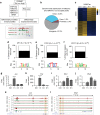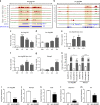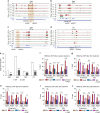Regulation of angiotensin II actions by enhancers and super-enhancers in vascular smooth muscle cells
- PMID: 29133788
- PMCID: PMC5684340
- DOI: 10.1038/s41467-017-01629-7
Regulation of angiotensin II actions by enhancers and super-enhancers in vascular smooth muscle cells
Abstract
Angiotensin II (AngII) promotes hypertension and atherosclerosis by activating growth-promoting and pro-inflammatory gene expression in vascular smooth muscle cells (VSMCs). Enhancers and super-enhancers (SEs) play critical roles in driving disease-associated gene expression. However, enhancers/SEs mediating VSMC dysfunction remain uncharacterized. Here, we show that AngII alters vascular enhancer and SE repertoires in cultured VSMCs in vitro, ex vivo, and in AngII-infused mice aortas in vivo. AngII-induced enhancers/SEs are enriched in binding sites for signal-dependent transcription factors and dependent on key signaling kinases. Moreover, CRISPR-Cas9-mediated deletion of candidate enhancers/SEs, targeting SEs with the bromodomain and extra-terminal domain inhibitor JQ1, or knockdown of overlapping long noncoding RNAs (lncRNAs) blocks AngII-induced genes associated with growth-factor signaling and atherosclerosis. Furthermore, JQ1 ameliorates AngII-induced hypertension, medial hypertrophy and inflammation in vivo in mice. These results demonstrate AngII-induced signals integrate enhancers/SEs and lncRNAs to increase expression of genes involved in VSMC dysfunction, and could uncover novel therapies.
Conflict of interest statement
The authors declare no competing financial interests.
Figures










Similar articles
-
A Novel Angiotensin II-Induced Long Noncoding RNA Giver Regulates Oxidative Stress, Inflammation, and Proliferation in Vascular Smooth Muscle Cells.Circ Res. 2018 Dec 7;123(12):1298-1312. doi: 10.1161/CIRCRESAHA.118.313207. Circ Res. 2018. PMID: 30566058 Free PMC article.
-
Angiotensin II-Induced Long Non-Coding RNA Alivec Regulates Chondrogenesis in Vascular Smooth Muscle Cells.Cells. 2021 Oct 9;10(10):2696. doi: 10.3390/cells10102696. Cells. 2021. PMID: 34685676 Free PMC article.
-
LncRNA MALAT1-Targeting Antisense Oligonucleotide Ameliorates the AngII-Induced Vascular Smooth Muscle Cell Proliferation and Migration Through Nrf2/GPX4 Antioxidant Pathway.J Cardiovasc Pharmacol. 2024 Nov 1;84(5):515-527. doi: 10.1097/FJC.0000000000001521. J Cardiovasc Pharmacol. 2024. PMID: 38086068 Free PMC article.
-
Reactive Oxygen Species: Modulators of Phenotypic Switch of Vascular Smooth Muscle Cells.Int J Mol Sci. 2020 Nov 20;21(22):8764. doi: 10.3390/ijms21228764. Int J Mol Sci. 2020. PMID: 33233489 Free PMC article. Review.
-
Pathogenic role of super-enhancers as potential therapeutic targets in lung cancer.Front Pharmacol. 2024 Apr 12;15:1383580. doi: 10.3389/fphar.2024.1383580. eCollection 2024. Front Pharmacol. 2024. PMID: 38681203 Free PMC article. Review.
Cited by
-
Epigenomes in Cardiovascular Disease.Circ Res. 2018 May 25;122(11):1586-1607. doi: 10.1161/CIRCRESAHA.118.311597. Circ Res. 2018. PMID: 29798902 Free PMC article. Review.
-
Palmitic acid alters enhancers/super-enhancers near inflammatory and efferocytosis-associated genes in human monocytes.J Lipid Res. 2025 Apr;66(4):100774. doi: 10.1016/j.jlr.2025.100774. Epub 2025 Mar 9. J Lipid Res. 2025. PMID: 40068774 Free PMC article.
-
A Low Concentration of Citreoviridin Prevents Both Intracellular Calcium Deposition in Vascular Smooth Muscle Cell and Osteoclast Activation In Vitro.Molecules. 2023 Feb 10;28(4):1693. doi: 10.3390/molecules28041693. Molecules. 2023. PMID: 36838684 Free PMC article.
-
The Regulatory Role of Histone Modification on Gene Expression in the Early Stage of Myocardial Infarction.Front Cardiovasc Med. 2020 Nov 30;7:594325. doi: 10.3389/fcvm.2020.594325. eCollection 2020. Front Cardiovasc Med. 2020. PMID: 33330655 Free PMC article.
-
Unlocking the secrets of aging: Epigenetic reader BRD4 as the target to combatting aging-related diseases.J Adv Res. 2024 Sep;63:207-218. doi: 10.1016/j.jare.2023.11.006. Epub 2023 Nov 11. J Adv Res. 2024. PMID: 37956861 Free PMC article. Review.
References
Publication types
MeSH terms
Substances
Grants and funding
LinkOut - more resources
Full Text Sources
Other Literature Sources
Medical
Molecular Biology Databases
Research Materials

